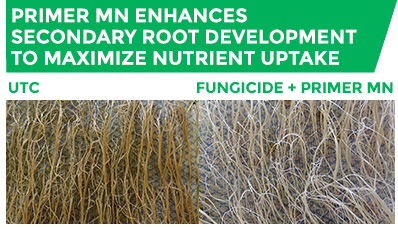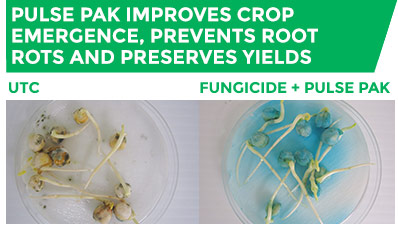Product Spotlight: Primers
Harvesting more bushels on the same acreage over the years leads to a diminishing reserve of essential nutrients in the soil and to a lower nutrient density in the seed. Once grasslands, Western Canadian Prairie soils have been converted to agriculture, used for high value crops such as cereals, canola, pulses, potatoes and others. Crop removal keeps increasing while replenishment remains the same or diminished, due to a variety of factors, such as tighter rotations, tighter budgets and slow mineralisation. It is no surprise to see sluggish crops struggling for emergence and establishment early in the spring.
To remediate the lack of essential nutrients in the seed, seed dressings, also known as Primers®, were developed back in the early 2000s to provide the seed with enough nutrients to carry it through until the root systems can develop and tap into the side-banded fertilizer. Most Primers were formulated with a phosphorus, potassium and zinc base – nutrients not readily available to the crop at seeding due to cold and/or wet conditions.

Other essential nutrients, such as manganese, copper and calcium, were added to the base to address deficiencies and the inability of the soil to transfer these nutrients to the seedlings due to pH or other conditions. For example, manganese is a key in triggering the plant’s natural defenses to fend off diseases. When used in conjunction with seed treatment fungicides, Primer Mn was proven to reduce seed- and soil-borne diseases and improve the overall health of the established crop.
Canola with its peculiarities took us back to the drawing board to formulate a crop-specific product that includes a wide range of essential nutrients. Revisiting the essential 16 was a must to establish the best ratios to optimize emergence, establishment, growth and vigor under the wide variety of conditions encountered across the Prairies.
We addressed a series of other challenges while formulating a Primer for pulse crops that is rhizobium-friendly and provides enough calcium to sustain root growth and optimal nodulation. For soybeans, concentrating the product enough to reduce inclusion volume was essential to better the efficiency during treatment at seed treating facilities.
Given the fall and winter we had, Prairie soils will be slow to warm up this spring, leaving the crops with unavailable phosphorus, potassium and zinc – essential for their initial stages of growth and development. Dressing the seeds with Primers will be a crucial step to give crops a Stronger Start. In addition, wet conditions during the 2016 growing season made it ideal for diseases and pathogens to thrive.

To minimize the impact of soil- and seed-borne diseases and reduce pathogen populations in the field, seed lots need to be sent away for a fungal screen then dressed with Primer Mn in combination with the right seed treatment. As well, the challenges encountered during harvest led to compaction, which will greatly reduce potassium availability in spring 2017. Most of the soil anions (nitrate-N, sulfur, boron and molybdenum) were exposed to leaching due to heavy rain and excess moisture in the soil, which also affects microbial activity and mineralisation.
OMEX offers a line of seven primers, each expertly developed to meet the specific nutritional needs of crops like cereals, oilseeds, soybeans and pulses, with unique blends of micro- and macronutrients. Give us a call today to find out more about selecting the right OMEX Primers® to get your crop off to a great start this season.
